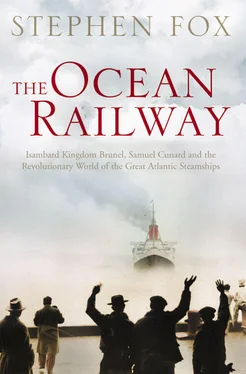While ship interiors became plusher and better equipped, the East River shipwrights puzzled over how to increase speed without losing cargo space. By slow degrees, the rounded bow and plump midship lines of the first packets gave way to faster ships with longer, thinner hulls and sharper bows and sterns. Shipwrights believed intuitively that speed also required a V-shaped hull, tapering down to a narrow keel at the bottom of the ship. These design tendencies all meant less payload and lower profits for a ship of a given length.
A solution to this tightening dilemma was discovered accidentally. In the early 1830s, Edward Knight Collinsof New York started running coastal packets to New Orleans. Because the bar at the mouth of the Mississippi River required ships of shallow draught, the New Orleans packets were built with flat bottoms; speed was not deemed so important in the coastal traffic. But it turned out, to general surprise, that flat hulls did not make the ships any slower or harm their sailing qualities. A flat bottom also let a ship rest upright when grounded by a low tide.
In 1836 Collins launched his Dramatic Line of flat-bottomed packets to Liverpool, with ships named for famous theatrical figures. Flamboyant and excessive, indeed theatrical, and bold to the point of recklessness, Collins left the competition in his foaming wake. His Shakespeare was 142 feet and 747 tons; his Garrick, Sheridan and Siddons, 158 feet and 895 tons each; and the Roscius, at 168 feet, was the first New York packet to exceed 1000 tons (and to cost $100,000). Collins also moved his passenger cabins from below deck, where they were subject to nauseating bilge odours, to a long deckhouse on the main deck stretching from the stern almost to the central mainmast. Up there, the cabins got more air and light – but without making the ship top-heavy or harming her behaviour or safety. The cabins themselves were three times larger than those on the first Black Ball ships. The Dramatic Line’s food, wines and decor all set new standards of elegance. And the ships were fast. Over their first ten years, the New York packets had averaged twenty-four days out, thirty-eight days home – excellent times compared to those of previous ships. By 1839 the Collins packets, the swiftest in the trade, had cut those averagesto twenty days, twelve hours and thirty days, twelve hours. Ocean travel had never before made such vaulting strides in only two decades.
An ocean voyage, in this era or any other, had to work around three endemic aspects of the experience: seasickness, danger and boredom. The worst bouts of mal de mer usually lifted after the first few days but could last longer, especially for women and in heavy seas. Any ship – in particular a sailing vessel – remained at the mercy of mighty natural forces, and on the heavily travelled North Atlantic might also collide with another ship or with an iceberg. Every day passengers had to find ways to kill time, a search that became more desperate and exhausted towards the end of the passage. ‘ A sea voyage…is a sort of Purgatory under the best of circumstances,’ William Young of Halifax, Nova Scotia, wrote in his journal aboard a packet in 1839. ‘You can follow no regular employment and tho’ not sick, I am never quite well enough for study. You can’t write on account of the motion and one’s reading is uninstructive and desultory.’ Young and his fellow passengers enjoyed clean berths, attentive service, abundant food and drink, and clear sailing. ‘And yet, from a sea voyage, Good Lord deliver me.’
A packet voyage began with the captain. A safe passage depended absolutely on his skill, judgment and tenacity. He had to make the daily computations with sextant and chronometer that established the ship’s position and heading. At any time of day and night, he might order sailorsaloft to set or take in sail. All steel and velvet, he was supposed to charm the passengers and, on occasion, bully the crew. His authority was final in all shipboard matters; yet he was ultimately just another mortal dealing with the unknowable mysteries of sailing the ocean. Every sailing ship displayed her own individual personality: what sailors called ‘ ship sense’, an ineffable quality of seeming alive, even of having consciousness. Under way, each seagoing amalgam of natural materials – of wood, hemp and canvas – thrummed a unique vibration which the captain could feel tingling from the rudder to the wheel, and hear blowing overhead through the sails and rigging. The trick was to pay careful attention and work with the ship, not to dominate her. To the extent that a packet voyage responded to mere human will and intention, it came down to a captain and his ship getting along well.
Passengers would pay their one-way fares of $140 to secure a particular captain as much as for his particular ship or packet line. An especially popular commander – such as George Maxwell of the Black Ball, Nash DeCost of the Blue Swallowtail, or Nathaniel Palmer of the Dramatic – reliably attracted extra business. That meant more money for the captain himself, because he typically owned a one-eighth stake in his ship and received 5 per cent of the freight and steerage charges and 25 per cent of the cabin fares. The governments in Washington and London also paid him two cents for each American letter and two pence (four cents) for each British letter he carried. These extras brought his nominal annual salary of $360 up to as much as $5000 a year, a plush income at the time. The packets therefore drew the services of the best captains on the Atlantic.
The crews were made up of sailors from many nations of Europe and North America. The cooks and stewards were usually black Americans, ‘ clever mulattoes’, according to James Fenimore Cooper, ‘who have caught the civilization of the kitchen.’ Passengers had most of their shipboard contact with the stewards, who served food, cleaned and fetched, and answered redundant questions about the weather and general course of the trip. The sailors kept to themselves, bunking in cramped quarters in the forecastle at the bow of the ship and conversing in the arcane, excluding patois of the sea. Passengers would marvel, from a distance, at the sailors’ strength and agility as they danced around the rigging in all weathers and acted variously as tailor, carpenter, cooper, stevedore, clerk and astronomer. It was easy to romanticize their often brief, dangerous lives. Captains drove the packets hard, always to the limit that sails and masts could bear, straining for speed. That meant constant action in the rigging (especially in bad weather), much bellowing and cursing, and sailors occasionally falling to their sudden deaths.
Everyone, ships and humans, remained at the indifferent mercy of the North Atlantic Ocean, in particular of the capricious wind. ‘ We are pensionersof the wind,’ Ralph Waldo Emerson wrote in his journal at sea in 1833. ‘All our prosperity, enterprize, temper come and go with the fickle air. If the wind should forget to blow we must eat our masts.’ A ship could lie becalmed in mid-ocean for a week or more, the wilted sails slapping irritatingly against the masts, the ship rising and falling helplessly on the endless swells. At the other extreme, too much wind brought its own delights. In April 1831 the Presidentof the London Black X Line picked her way from New York through twelve straight days of cold, dense fogs and heavy, rolling seas. A fierce gale pushed waves almost up to her topmast. As the ship rolled back and forth on her bow-to-stern axis, water came over the five-foot bulwarks onto the deck, then into the cabins below. The captain, standing in water up to his knees, could not leave his post for twenty-four hours. The President limped into port after a hard passage of thirty-nine days. Other ships at journey’s end might come within tantalizing sight of land and then have to spend days tacking back and forth along the coast, held at sea by contrary winds.
Читать дальше












